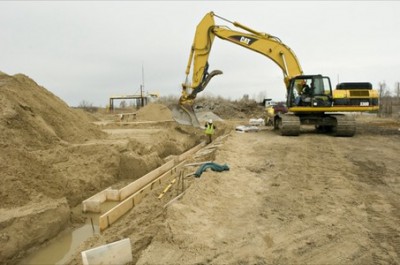A bill that passed the N.C. House will overhaul the process for state-funded projects. We reprinted this breakdown from North Carolina Health News.
In the recent rush to approve bills before a self-imposed deadline, N.C. House lawmakers approved legislation that could transform a decades-old environmental law.
Supporter Spotlight
The bill, HB 795, would rewrite central provisions of the State Environmental Policy Act, or SEPA, by potentially cutting the number of projects addressed by the law.
What is SEPA? And how would HB 795 affect the health of North Carolinians?
To help readers navigate the divisive debate, North Carolina Health News has put together a primer on this complex piece of public policy.
What are SEPA’s origins?

In the 1970s, the U.S. enacted several sweeping environmental laws. Among those was the National Environmental Policy Act, which requires that federal agencies review their activities’ environmental effects. In 1971, North Carolina followed suit and passed its own version. SEPA functions like its federal counterpart but only applies to state agencies and state-funded projects.
Supporter Spotlight
The law’s authors included high ideals in their legislation. SEPA says that “to assure that an environment of high quality will be maintained for the health and well-being of all … it shall be the continuing policy of the State of North Carolina to conserve and protect its natural resources and to create and maintain conditions under which man and nature can exist in productive harmony.”
SEPA’s authors, in describing the legislation’s purpose, also pointed to the ideal of transparency. The authors stipulated that state agencies should publicly report on the environmental effects of taxpayer-funded works.
When does SEPA apply to a public project?
Currently, SEPA reviews begin when an activity hits three main criteria: It must involve a state agency’s action, such as a pollution permit or a roads-construction project; it must involve the use of public money (state or local) or state land; and it must have the potential to negatively affect the environment or public health.
Who’s involved?
State agencies run the SEPA-review process. The “lead” agency is the one performing the activity – issuing a permit for a landfill, for example. But other agencies are also involved and review the lead agency’s assessments. This allows state specialists, with expertise in, say, transit planning or agriculture, to weigh in on a state activity.
What’s an ‘activity’ under SEPA?
A state agency could be issuing a permit for a wastewater treatment plant. A local government could be building a sewer-line extension. Or a state agency could be issuing licenses for solar-energy plants. The possibilities are many, so long as they touch on the three criteria listed above.
How does SEPA involve human health?
The public’s health is an explicit consideration for SEPA reviews.
SEPA reviews consider air quality, groundwater quality, drinking-water supplies and the potential to create hazardous wastewater.

How many SEPA reviews take place each year?
From 2013 to 2014, the state processed 323 SEPA reviews, according to Crystal Best, an official in the state’s Department of Administration. Of those, 288 reviews covered solar-energy projects, which require state licenses.
What benefits do people highlight in SEPA?
Municipal projects often must secure environmental permits, such as air-pollution permits. Applying for those permits can be a complex process, but SEPA can help, according to Lyn Hardison, the SEPA coordinator at the N.C. Department of Environment and Natural Resources, or DENR.
“It’s kind of a permit assistance tool,” she said. “When they get all this information together and they get a final [SEPA] document … from there the application and the permitting process should be a breeze.”
SEPA is not a regulatory program; it doesn’t set legally enforceable limits on air pollution, for example. That’s what permits are for. Yet some environmental permits lack the comprehensive scope of SEPA, according to Robin Smith, who served as DENR’s assistant secretary for the environment from 1999 to 2012.
If a proposed plant will emit toxic air pollution, for example, its pollution permit may require the installation of technologies to control the pollution, Smith said. But the permit won’t take into account local conditions.
“A site-specific evaluation really isn’t the way the Clean Air Act works,” she said. “And it is something that SEPA can do…. You’re supposed to look at all of the impacts of the project, not just on air quality but also on human health, on the community, on a whole range of impacts.”
What about SEPA’s drawbacks?
As environmental science grows more fine-tuned and as legal requirements have increased, SEPA reviews have grown increasingly expensive, according to Kenneth Waldroup, an assistant director in Raleigh’s public utilities department.
Waldroup, who works on SEPA reviews, noted that projects already face numerous, complex environmental regulations.
“There is a need for [SEPA],” he said. But the combination of SEPA and other state and federal laws, he said, “has made the permitting and development of new projects extremely complicated.”
SEPA requires that agencies consider alternatives to their proposals. But Waldroup said this can lead to “analysis paralysis.” The process also allows outside agencies to request resource-intensive studies, some of which can be unrelated to the project. This happened when Raleigh was considering using Falls Lake as a hydroelectric power source, nearly closing the door on the project before the city could consider its financial viability, he said.

What does HB 795 do?
The bill, which is now before the Senate, would set a monetary threshold for SEPA review. Projects costing less than $10 million would be excluded from review. It would also exclude projects that affect less than five acres of upland property.
Additionally, HB 795 would limit the scope of SEPA, requiring that agencies only consider direct environmental impacts. Currently, agencies also consider indirect and cumulative impacts.
How many projects would HB 795 affect?
It’s unclear. SEPA currently does not address projects based upon their cost. At DENR, the department doesn’t require financial information about projects it reviews under SEPA.
Rep. Chuck McGrady, R-Hendersonville, a vice chairman of the House Environment Committee, said that a $10 million threshold would exclude many projects from SEPA review. Hardison echoed McGrady, and said that while she didn’t have an average cost of SEPA-reviewed projects, a monetary threshold would reduce the number of projects facing SEPA scrutiny.
What do proponents of HB 795 say?
In a column in the Raleigh News & Observer, Lew Ebert, the chief executive officer of the N.C. Chamber, said that HB 795 would help cut legal red tape, which is stifling job creation.
Rep. Chris Millis, R-Hampstead, a primary sponsor of the bill, argued that the state now has enough environmental regulations on its books.
What do critics say?
McGrady said that HB 795 is essentially a repeal of SEPA.
Robin Smith, the former DENR official, argued that a project’s cost is not a good proxy for its environmental impact.
Any other opinions on the matter?
Waldroup, from Raleigh’s utilities agency, said that SEPA fills gaps left by federally required environmental permits. But, he added, there’s still a need to debate the law.
“I think there is some reasonable argument that some of the thresholds in SEPA, as it exists today, may be overly complex for small projects,” he said. “I think there’s a reasonable discussion about, should the SEPA thresholds change based on our experience for these projects? Are these projects truly impactful to the environment?
“I do not know if $10 million is an appropriate threshold, or whether we should go back and look at the size of the stations and the size of the pipes that are being replaced, and the length of pipes, and reconsider it from that standpoint.”







